One of the most surprising, and gratifying, things that has happened since I started my blog, Tim Maughan Books, a year or so ago is the positive feedback I’ve had for the anime reviews—especially from people I know are far from being massive fanboys like myself. It’s gratifying because its part of the reason I started writing them; to try and introduce the medium to people who had never really indulged in it all, at least not past perhaps watching Spirited Away with their kids. The problem is, once you’ve had your first taste, where do you go next? Type ‘anime’ into Google and the results are bewildering, and without a little bit of guidance and a quality filter finding something to watch can be a daunting task. There’s a lot of shit out there, plus a lot of stuff that isn’t really meant for you unless you’re a ADHD stricken 12 year old emo-ninja-obsessed boy that refuses to eat anything except Pocky and instant Ramen. So, as requested, I present my list of 10 ‘mature’ anime films you really should see. They are in no particular order, the term ‘mature’ is kind of loose, seeing as at least two are really kids’ films, and this is purely personal opinion. If you disagree, see you in the comments section.
Akira (1988)
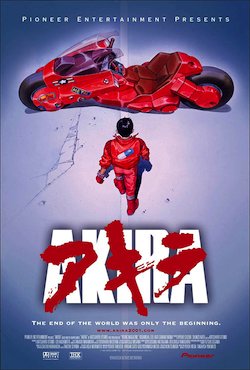 For many of us in the west, this is the one that started it all. Up until we first saw Katsuhiro Otomo‘s Akira, our only exposure to Japanese animation had been kiddies’ Saturday morning shows like Speed Racer and Battle of the Planets, but I can still remember vividly sitting in a run-down arthouse cinema at the age of 17 with my jaw resting on the sticky floor as the opening scenes flashed in front of me. Two hours later I was a complete convert. Otomo heavily edited and re-wrote his own epic manga about rival motorbike gangs and genetically enhanced children to create this futuristic thriller, and it blew away critics and audiences in the west while breaking box office records back home in Japan. It also opened the floodgates for anime into the US and Europe, but unfortunately with a lot of what was opportunistically exported (distributors looking for visually similar/violent material instead of quality) simply not being up to the same standard many potential new fans were turned off as quickly as they’d been turned on. Essential viewing.
For many of us in the west, this is the one that started it all. Up until we first saw Katsuhiro Otomo‘s Akira, our only exposure to Japanese animation had been kiddies’ Saturday morning shows like Speed Racer and Battle of the Planets, but I can still remember vividly sitting in a run-down arthouse cinema at the age of 17 with my jaw resting on the sticky floor as the opening scenes flashed in front of me. Two hours later I was a complete convert. Otomo heavily edited and re-wrote his own epic manga about rival motorbike gangs and genetically enhanced children to create this futuristic thriller, and it blew away critics and audiences in the west while breaking box office records back home in Japan. It also opened the floodgates for anime into the US and Europe, but unfortunately with a lot of what was opportunistically exported (distributors looking for visually similar/violent material instead of quality) simply not being up to the same standard many potential new fans were turned off as quickly as they’d been turned on. Essential viewing.
Ghost in the Shell (1995)
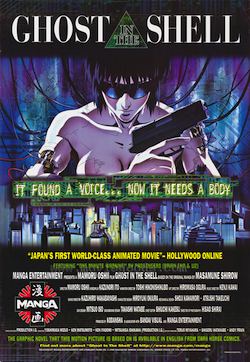 One of the most influential anime films of all time, Mamoru Oshii‘s Ghost in the Shell changed not only the look and feel of animated sci-fi but also had an impact on Hollywood; most notably in the distinct visual style of the Matrix movies. While some hardcore fans of Masamune Shirow‘s original action-packed and often light hearted manga still complain about the adaption; Oshii’s decision to turn it into a dark, brooding, beautifully paced drama ensured it’s place as a science fiction classic. It is without doubt the definitive visual depiction of the cyberpunk movement, and the closest there is to date of a filmic version of William Gibson’s classic Sprawl Trilogy novels. Not just a huge worldwide hit, it also spawned a huge franchise including a sequel, a planned Hollywood remake, two 26 part TV series, various novels, toys and video games, as well as the recent controversial Ghost in the Shell 2.0 special edition.
One of the most influential anime films of all time, Mamoru Oshii‘s Ghost in the Shell changed not only the look and feel of animated sci-fi but also had an impact on Hollywood; most notably in the distinct visual style of the Matrix movies. While some hardcore fans of Masamune Shirow‘s original action-packed and often light hearted manga still complain about the adaption; Oshii’s decision to turn it into a dark, brooding, beautifully paced drama ensured it’s place as a science fiction classic. It is without doubt the definitive visual depiction of the cyberpunk movement, and the closest there is to date of a filmic version of William Gibson’s classic Sprawl Trilogy novels. Not just a huge worldwide hit, it also spawned a huge franchise including a sequel, a planned Hollywood remake, two 26 part TV series, various novels, toys and video games, as well as the recent controversial Ghost in the Shell 2.0 special edition.
My Neighbor Totoro (1988)
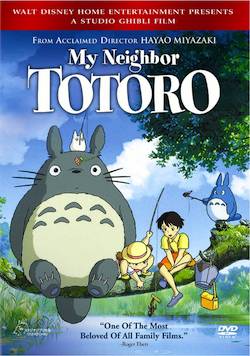 I’ve talked at length elsewhere about how personally important My Neighbour Totoro is to me, so here I’ll try not to gush too much. There’s so many reasons as to why Hayao Miyazaki‘s masterpiece is such an enduring and perfect film; the way he captures the energy and personalities of it’s two child protagonists, and his never ending attention to detail combined with a beautifully simple score and Kazuo Oga‘s immaculate and breath-taking background paintings make it a joy to watch over and over again. A fact I’ve been re-assured of by friends with young children that insist on watching it on a near daily basis. And that’s probably Totoro‘s strongest point—the fact that it is family film that appeals to both children and adults alike without pandering to either with slapstick or ‘knowing’ humor. If you haven’t seen it yet then you must—it is quite possibly the greatest animated film ever made.
I’ve talked at length elsewhere about how personally important My Neighbour Totoro is to me, so here I’ll try not to gush too much. There’s so many reasons as to why Hayao Miyazaki‘s masterpiece is such an enduring and perfect film; the way he captures the energy and personalities of it’s two child protagonists, and his never ending attention to detail combined with a beautifully simple score and Kazuo Oga‘s immaculate and breath-taking background paintings make it a joy to watch over and over again. A fact I’ve been re-assured of by friends with young children that insist on watching it on a near daily basis. And that’s probably Totoro‘s strongest point—the fact that it is family film that appeals to both children and adults alike without pandering to either with slapstick or ‘knowing’ humor. If you haven’t seen it yet then you must—it is quite possibly the greatest animated film ever made.
Porco Rosso (1992)
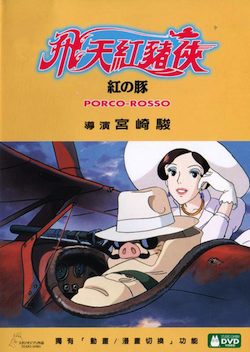 I’ve already got one Miyazaki movie in this list, and it’s hard to limit it to just two. Picking a second one is even harder. My opinion changes on a near daily basis, or depending on the last one I happened to watch. But I’ll always have a soft spot for Porco Rosso; the tale of a WWI fighter ace turned bounty-hunter, cursed with the head of a pig and on the run for going AWOL from the Italian air force. In many ways it must have been one of Miyazaki’s most enjoyable projects to create, another fantastic family film that somehow manages to combine his obsession with aeronautic design and his personal politics. The elaborate, lived in aircraft designs remain one of my favourite cinematic images of all time, while we learn that the reason Rosso is fleeing the Italian authorities is his disdain for the fascism that’s steadily taking grip of Europe. Oh, and he also manages to take a gentle swipe at US bravado along the way. A perfect film.
I’ve already got one Miyazaki movie in this list, and it’s hard to limit it to just two. Picking a second one is even harder. My opinion changes on a near daily basis, or depending on the last one I happened to watch. But I’ll always have a soft spot for Porco Rosso; the tale of a WWI fighter ace turned bounty-hunter, cursed with the head of a pig and on the run for going AWOL from the Italian air force. In many ways it must have been one of Miyazaki’s most enjoyable projects to create, another fantastic family film that somehow manages to combine his obsession with aeronautic design and his personal politics. The elaborate, lived in aircraft designs remain one of my favourite cinematic images of all time, while we learn that the reason Rosso is fleeing the Italian authorities is his disdain for the fascism that’s steadily taking grip of Europe. Oh, and he also manages to take a gentle swipe at US bravado along the way. A perfect film.
Voices of a Distant Star (2002)
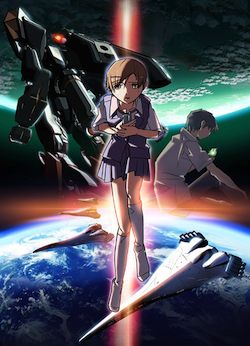 Perhaps Voices of a Distant Star doesn’t really belong here. For a start its only 25 minutes long, and was first released on DVD, technically making it an OVA—which I said at the top of this post wouldn’t be included here. Well, rules are made to be broken, plus it earns its place on this list for truly being a film you must see before you die. Astonishing enough that it was single-handedly written, directed and animated by the now legendary Makoto Shinkai on his Mac at home, it is also one of the most touching, beautiful and exhilarating examples of animation produced in recent history. The story of a long distant, text message relationship between a teenage mecha-pilot and her boyfriend back on earth, it combines gentle, slow-paced scenes with snatches of frantic sci-fi action, and has become the thematic and stylistic basis for Shinkai’s subsequent large-budget productions. It’s probably available for stupidly cheap on DVD now, so you really have no excuse for not picking this mini-masterpiece up.
Perhaps Voices of a Distant Star doesn’t really belong here. For a start its only 25 minutes long, and was first released on DVD, technically making it an OVA—which I said at the top of this post wouldn’t be included here. Well, rules are made to be broken, plus it earns its place on this list for truly being a film you must see before you die. Astonishing enough that it was single-handedly written, directed and animated by the now legendary Makoto Shinkai on his Mac at home, it is also one of the most touching, beautiful and exhilarating examples of animation produced in recent history. The story of a long distant, text message relationship between a teenage mecha-pilot and her boyfriend back on earth, it combines gentle, slow-paced scenes with snatches of frantic sci-fi action, and has become the thematic and stylistic basis for Shinkai’s subsequent large-budget productions. It’s probably available for stupidly cheap on DVD now, so you really have no excuse for not picking this mini-masterpiece up.
Royal Space Force: The Wings Of Honneamise (1987)
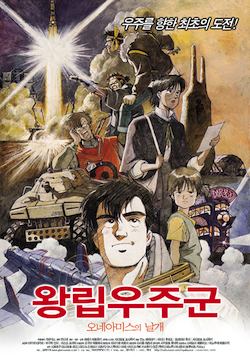 The feature film debut of the then still young—but now legendary—studio Gainax, Royal Space Force: The Wings of Honneamise is an unusual, compelling and skillfully crafted film. Both a coming of age story and detailed analysis of the role of the space race in the Cold War, RSF tells the story of an alternate reality Earth, where two rival superpowers are locked in a constant propaganda and military stalemate, while a small team of underfunded scientists, engineers and pilots attempt to launch the first man into space. While the film is beautifully animated with some fantastically detailed background art, it is also has substantial depth in terms of it’s philosophical themes and characterisation. As such it’s not one for the whole family, but an unmissable and enthralling watch for anyone with an interest in what animation can truly achieve.
The feature film debut of the then still young—but now legendary—studio Gainax, Royal Space Force: The Wings of Honneamise is an unusual, compelling and skillfully crafted film. Both a coming of age story and detailed analysis of the role of the space race in the Cold War, RSF tells the story of an alternate reality Earth, where two rival superpowers are locked in a constant propaganda and military stalemate, while a small team of underfunded scientists, engineers and pilots attempt to launch the first man into space. While the film is beautifully animated with some fantastically detailed background art, it is also has substantial depth in terms of it’s philosophical themes and characterisation. As such it’s not one for the whole family, but an unmissable and enthralling watch for anyone with an interest in what animation can truly achieve.
Patlabor: The Movie 2 (1993)
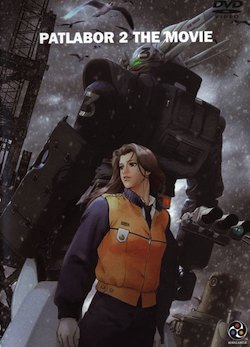 The history of the Patlabor franchise is a long and complex one, but put simply under the guidance of Mamoru Oshii it developed (in a way similar to how he remolded Ghost in The Shell) from a light hearted but realistic police-mecha drama to a bleak, deeply political and philosophical thriller by the time he directed Patlabor: The Movie 2. While the first movie is just as enthralling, thoughtful and arguably more accessible, the sequel just steals the crown due to its uncompromising approach to its political themes and it’s breathless, stark cinematic beauty. It deals with Oshii’s recurring theme of the hypocrisy of peace in the developed world, and in particular is a devastating attack on the foreign policy of a pacifist Japan that profits from the fates of distant waring nations. Although over 15 years old now, it’s portrayal of terrorism consists of some disturbingly prophetic imagery. Possibly the closest anime has come to producing something to rival the large canvas, cinematic styles of the likes of Stanley Kubrick or Ridley Scott, it is an unmissable, if challenging, work.
The history of the Patlabor franchise is a long and complex one, but put simply under the guidance of Mamoru Oshii it developed (in a way similar to how he remolded Ghost in The Shell) from a light hearted but realistic police-mecha drama to a bleak, deeply political and philosophical thriller by the time he directed Patlabor: The Movie 2. While the first movie is just as enthralling, thoughtful and arguably more accessible, the sequel just steals the crown due to its uncompromising approach to its political themes and it’s breathless, stark cinematic beauty. It deals with Oshii’s recurring theme of the hypocrisy of peace in the developed world, and in particular is a devastating attack on the foreign policy of a pacifist Japan that profits from the fates of distant waring nations. Although over 15 years old now, it’s portrayal of terrorism consists of some disturbingly prophetic imagery. Possibly the closest anime has come to producing something to rival the large canvas, cinematic styles of the likes of Stanley Kubrick or Ridley Scott, it is an unmissable, if challenging, work.
Perfect Blue (1997)
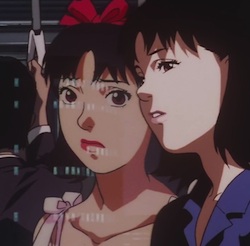 The directorial debut of anime auteur Satoshi Kon, Perfect Blue‘s story about a J-Pop idol turned actress being stalked by a obsessive fan was originally meant to be a live action drama, only scrapped due to the 1995 Kobe earthquake. At first it’s contemporary setting and often mundane situations are certainly reminiscent of a well-shot J-Horror movie, but in Kon’s skilled hands the script slowly changes into something that could only be depicted by animation. As a starting point for his re-occurring themes of disconnected realities and psychological fantasy it is subtler than his later works such as Paranoia Agent and Paprika, and as a result somehow creepier. Certainly it’s most famous scene—where we apparently see the central character being raped, only discovering she is just acting when the off camera director shouts ‘cut’—is one that permanently sticks in the mind, as does the film’s shocking, final revelation.
The directorial debut of anime auteur Satoshi Kon, Perfect Blue‘s story about a J-Pop idol turned actress being stalked by a obsessive fan was originally meant to be a live action drama, only scrapped due to the 1995 Kobe earthquake. At first it’s contemporary setting and often mundane situations are certainly reminiscent of a well-shot J-Horror movie, but in Kon’s skilled hands the script slowly changes into something that could only be depicted by animation. As a starting point for his re-occurring themes of disconnected realities and psychological fantasy it is subtler than his later works such as Paranoia Agent and Paprika, and as a result somehow creepier. Certainly it’s most famous scene—where we apparently see the central character being raped, only discovering she is just acting when the off camera director shouts ‘cut’—is one that permanently sticks in the mind, as does the film’s shocking, final revelation.
Memories (1995)
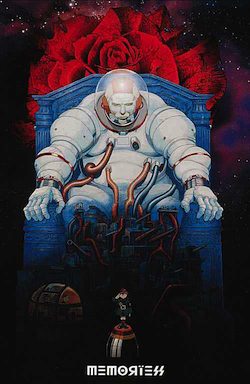 Produced by Katsuhiro Otomo, and based on some of his short manga stories, Memories is an anthology of three films. Although all science fiction they cover a wide range of styles, from the romantic, twisted reality of the Satoshi Kon scripted Magnetic Rose and the ludicrous bio-warfare black comedy Stink Bomb to the Orwellian, Brazil like dystopia of Cannon Fodder—the only one of the three directed by Otomo himself. It is arguably the most compelling of the three, with it’s Oshii-esque story of a war obsessed and controlled society and it’s unique, steampunkesque visuals. Despite the diverging themes and differing visual styles of the three chapters, there is an undeniably high standard of production throughout. It’s another film that can be easily and cheaply picked up on DVD at the moment, I can’t hesitate in recommending that you buy it on sight.
Produced by Katsuhiro Otomo, and based on some of his short manga stories, Memories is an anthology of three films. Although all science fiction they cover a wide range of styles, from the romantic, twisted reality of the Satoshi Kon scripted Magnetic Rose and the ludicrous bio-warfare black comedy Stink Bomb to the Orwellian, Brazil like dystopia of Cannon Fodder—the only one of the three directed by Otomo himself. It is arguably the most compelling of the three, with it’s Oshii-esque story of a war obsessed and controlled society and it’s unique, steampunkesque visuals. Despite the diverging themes and differing visual styles of the three chapters, there is an undeniably high standard of production throughout. It’s another film that can be easily and cheaply picked up on DVD at the moment, I can’t hesitate in recommending that you buy it on sight.
The Girl Who Leapt Through Time (2006)
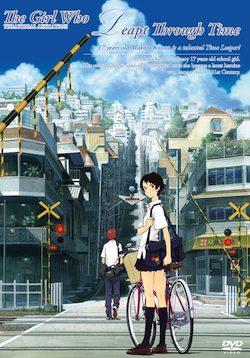 Loosely based on a popular Japanese novel, Mamoru Hosoda‘s The Girl Who Leapt Through Time tells the story of schoolgirl Makoto Konno, who discovers she has the ability to—literally—time leap; that is to jump back in time to change situations and remake important decisions. What starts as an enjoyable, funny and charming teenage drama slowly reveals itself to have a classic, well crafted science fiction story at it’s heart, offering another, stylish but gentle, take on the conundrums and paradoxes thrown up by the idea of time-travel. It’s partly in this list to represent the talent of more recent directors and studios, but mainly because it’s a warm, accessible, exciting and lovingly made film that will be held in high esteem for many, many years to come.
Loosely based on a popular Japanese novel, Mamoru Hosoda‘s The Girl Who Leapt Through Time tells the story of schoolgirl Makoto Konno, who discovers she has the ability to—literally—time leap; that is to jump back in time to change situations and remake important decisions. What starts as an enjoyable, funny and charming teenage drama slowly reveals itself to have a classic, well crafted science fiction story at it’s heart, offering another, stylish but gentle, take on the conundrums and paradoxes thrown up by the idea of time-travel. It’s partly in this list to represent the talent of more recent directors and studios, but mainly because it’s a warm, accessible, exciting and lovingly made film that will be held in high esteem for many, many years to come.
So what have I missed out? Where have I gone wrong? Well for a start I notice straight away that although there’s two Studio Ghibli films, there’s nothing by Isao Takahata—No Grave of the Fireflies or Only Yesterday—which can’t be right, surely? I guess it’s a good sign for anime’s heritage that compiling such a list and limiting it to just ten means so many great works are missing, but I’m sure some of you will be upset that I’ve left out your favourite personal masterpiece. If so, hit the comments below and let it all out.
That’s not all! Check out Ten Anime Series You Should See Before You Die
Tim Maughan lives in Bristol in the UK and has been writing about anime and manga for nearly four years, and consuming both for close to twenty. He also writes science fiction, and his debut book Paintwork is out this June. He also tweets way too much.









